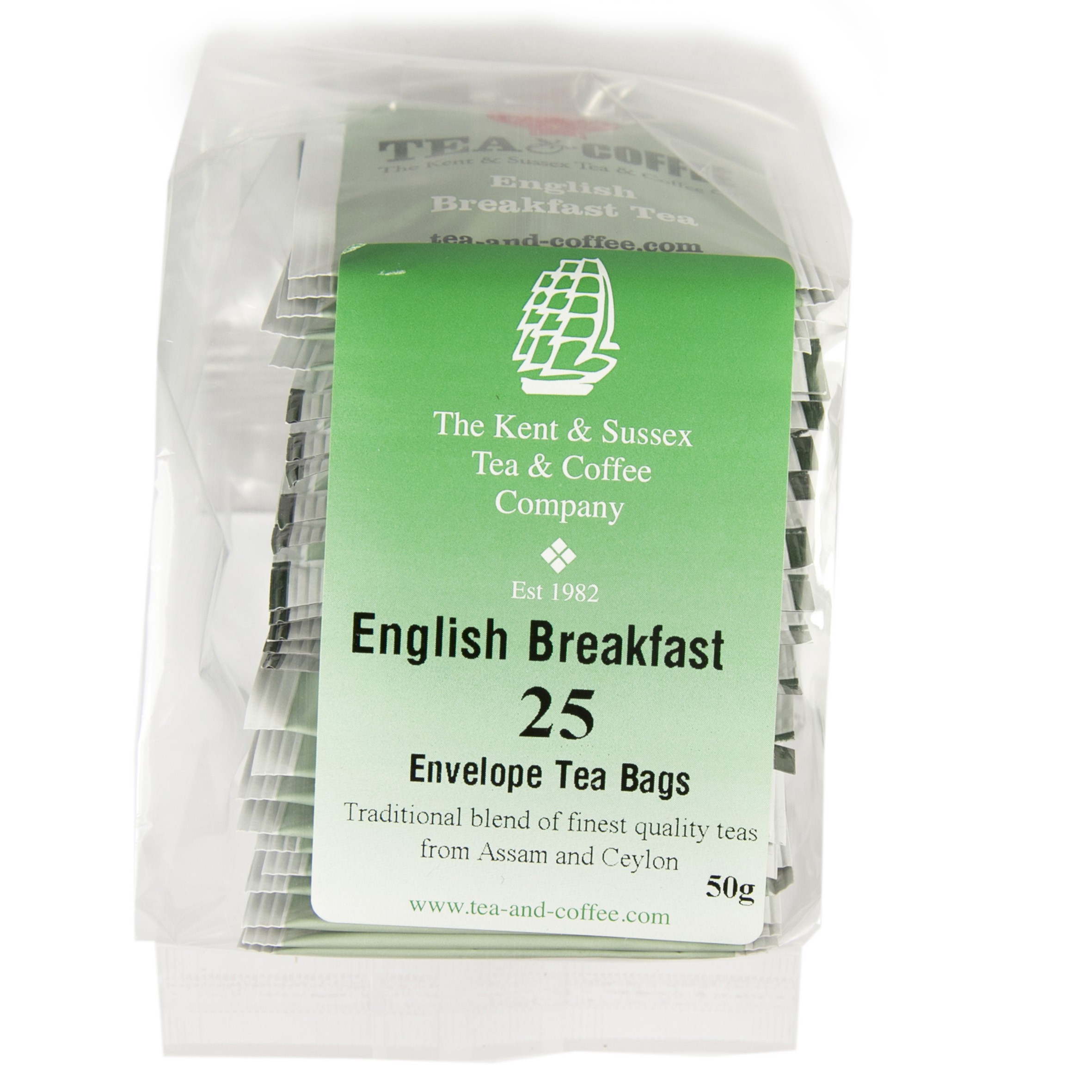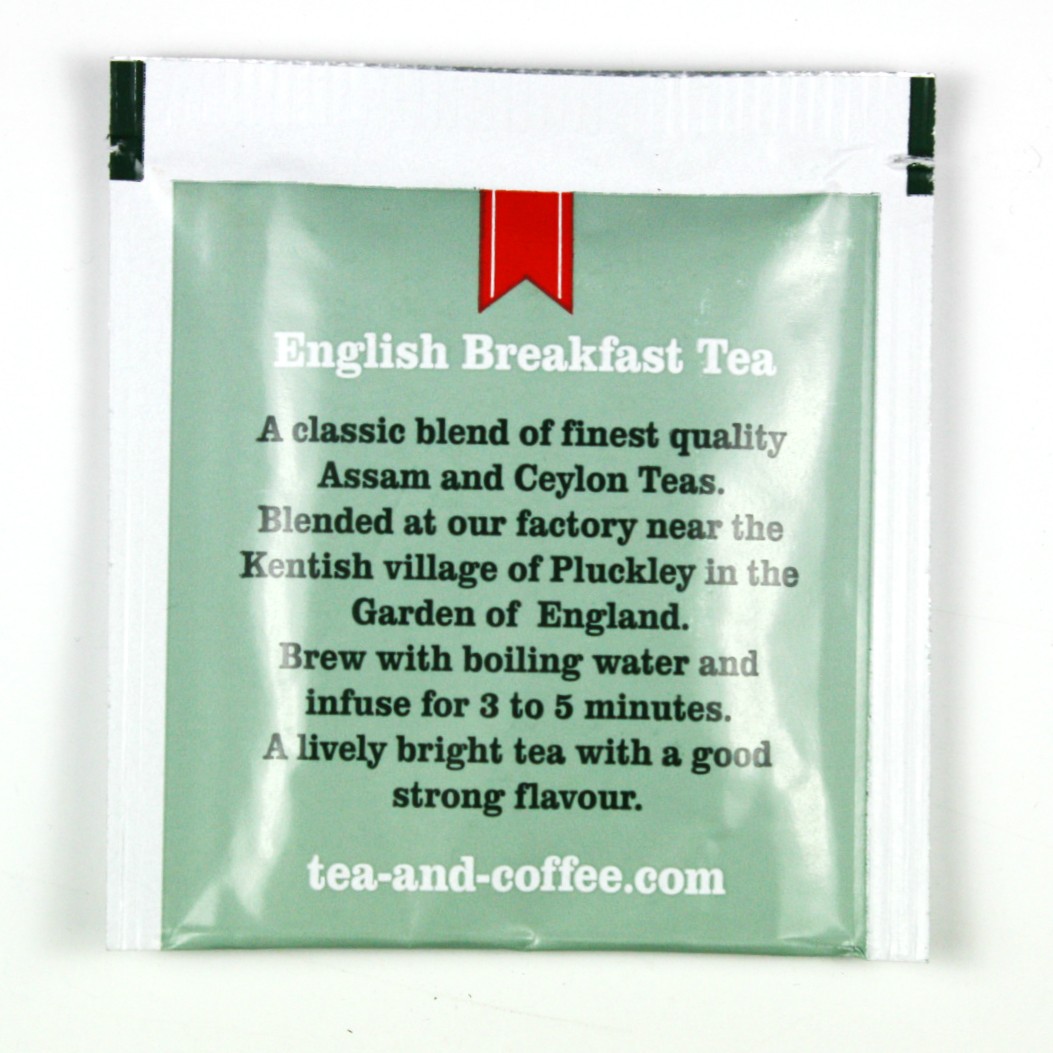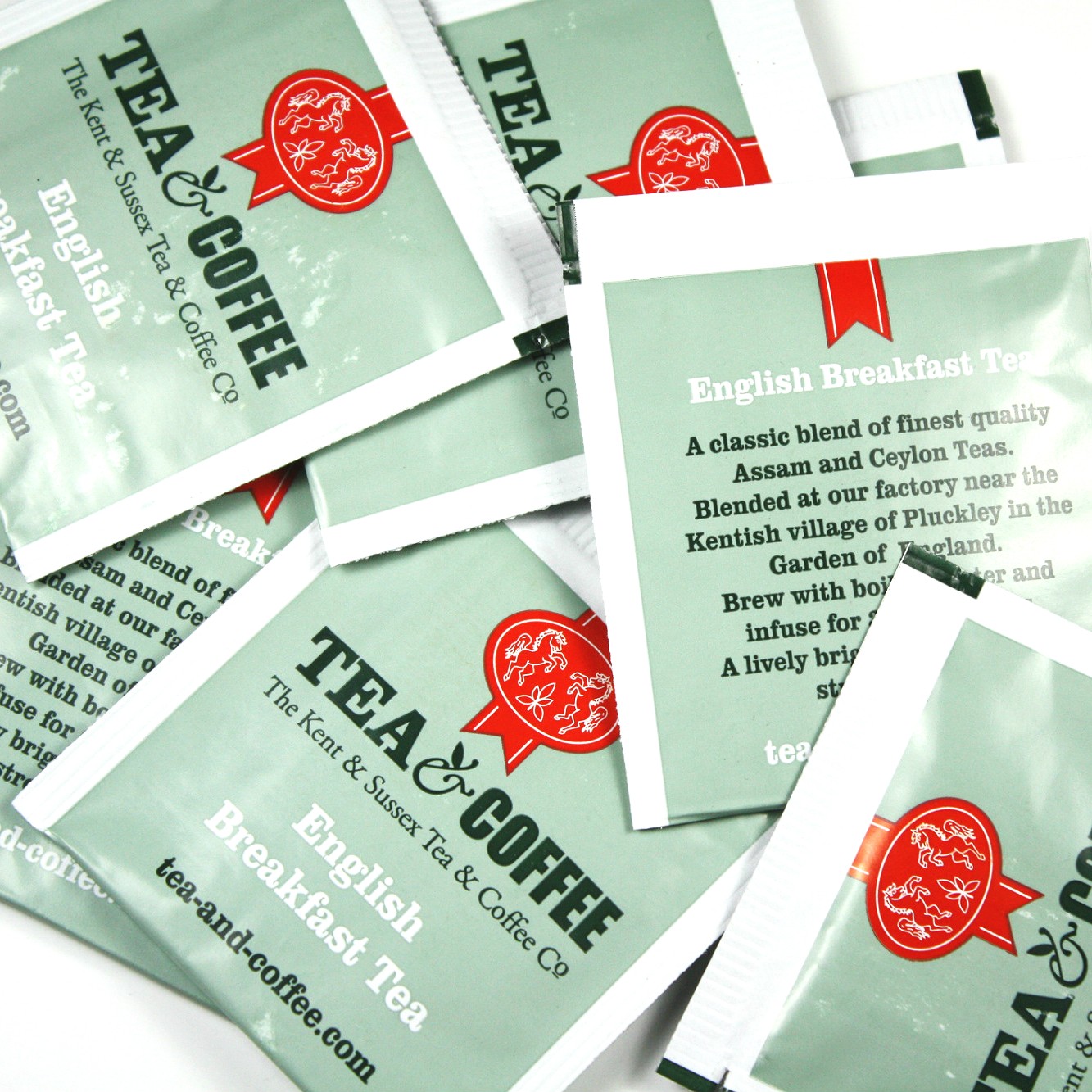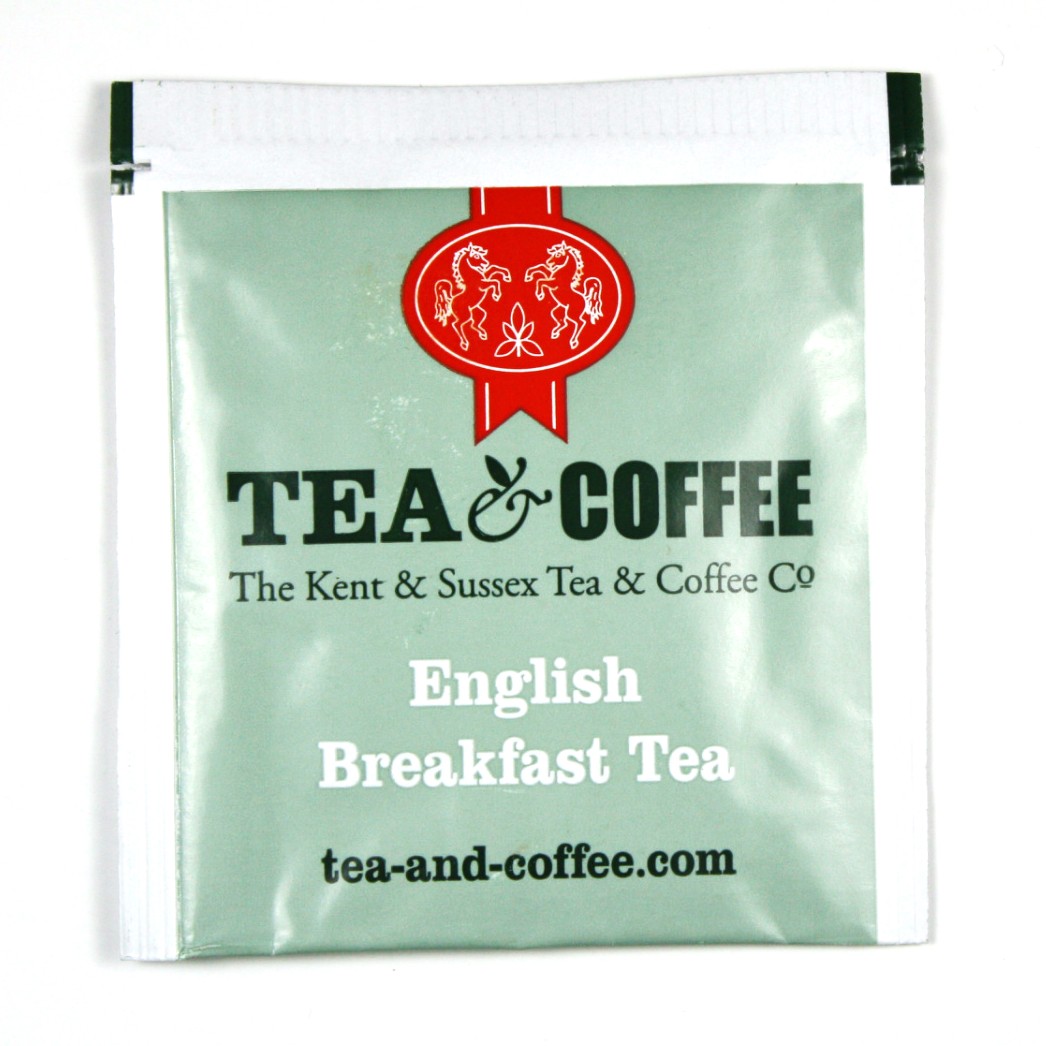English Breakfast Envelope Tea Bags
Black Tea Brewing Guide

1 Teaspoon
Add 1 teaspoon per person and one for the pot.

95⁰c - 100⁰c
Boil using fresh water, at a temperature of 95⁰ - 100⁰c.

3 - 5 Mins
Steep for 3-5 minutes, depending on personal preference
About Product
-
Product Description
We recommend English Breakfast 25 Envelope Tea Bags to those who like a bit of added style to their morning brew. Each colourful packet has our logo along with information on the Tea within.
Customers who have B&Bs or hotels, in particular, choose our English Breakfast 25 Envelope Tea Bags for not only its outer-appearance but also its extraordinary taste!
Why choose this Tea?
We use the finest quality blend of Assam and Ceylon Black Tea for the making of this beverage. Combined, they make a match made in heaven.
Flavours experienced with English Breakfast Tea are delectably malty and rich from start to finish, enticing the palate with every sip. What more could you possibly want from your morning cuppa’?
Assam Tea
In 1823, a Scottish explorer named Robert Bruce discovered an Indian variety of the Tea plant in Assam, India. This was the first example of Tea growing in the whole of India after repeated failed attempts to grow a Chinese variety of the Tea plant.
It gave rise to an Indian Tea industry. And it’s all thanks to Assam Tea!
Ceylon Tea
The Ceylon (present-day Sri Lanka) Tea Industry began in 1869. It came about because of failed Coffee crops across the island, which led to economic difficulty. Similar to Assam Tea, a Scotsman named James Taylor recognised the potential of Tea-growing in Ceylon.
He oversaw dramatic change within the economic landscape of the then-British colony. This, of course, lead to the much-loved Ceylon Tea.
Useful Information
Type of Tea: Black Tea.
Origins: Blend from Assam (India) and Ceylon (present day Sri Lanka).
Brewing Instructions: Brew using freshly boiled water. Infuse for 3 to 5 minutes.
How to Serve: We recommend serving this Tea black. However, some may choose to add milk or sugar, sometimes even honey or lemon.
Tasting Notes: This beverage offers everything one expects from a Breakfast Tea: flavoursome and malty with a rich aftertaste.
Colour in Cup: Bronze liquor, dark in tone.
Benefits of Drinking this Tea
Many believe that Black Tea has a negative impact on oral health. This simply isn’t true. In fact, it’s quite the opposite. New research has surfaced as part of a collaborative study conducted in conjunction with the College of Dentistry at the University of Iowa and the Institute of Odontology at Göteborg University in Sweden.
-
Delivery Information
We offer reliable delivery services through Royal Mail to ensure that your orders reach you on time.
Here are the main points you should be aware of:
- Standard UK Delivery: £3.95 excluding delivery charge.
- Delivery Times: Orders are processed and dispatched within 2-5 working days but they may take longer during busy times. It is worth noting that all our orders are packed by hand in order to maintain the quality.
- Free Delivery: We are delighted to provide free shipping for UK orders over £35*. Moreover, customers from Europe can enjoy free shipping for any purchase above €75*. Furthermore, we offer free delivery in the USA for all purchases exceeding $125*. Please note terms and conditions may apply.
- Tracking: When your package is sent you will receive a tracking number via email so as to keep tabs of its progress.
International Shipping
We do ship worldwide meaning our products can be accessed by anyone around the world.
Here are some important details:
- Delivery Times: International deliveries vary based on destination, generally taking between 7-14 working days.
- Shipping Costs: International shipping costs are calculated at checkout based on your location and weight of your order. View full delivery charges for your location.
- Customs and Import Duties: Remember customs or import duties may exist depending on regulations in your country; these charges are borne by the customer.
Returns Policy
Your satisfaction is our top priority, however if for any reasons you’re not completely happy with your purchase, simply follow our returns procedure:
- Eligibility: Items returned within 30 days of receipt must remain unopened and in their original condition.
- Process: In order to return an item contact our customer service department using your unique order number after which detailed instructions will be given concerning returning them back to us securely.
- Refunds: Our aim is to refund you within 5-7 working days upon successful reception of returned goods. The refund amount will be credited to your original payment method.
For any other Enquiries or help please contact our Customer Support Team always at your service.
-
Product Reviews

 Loose Leaf Tea
Loose Leaf Tea Pyramids
Pyramids Tea Bags
Tea Bags Africa
Africa Assam
Assam Ceylon
Ceylon Chinese
Chinese Darjeeling
Darjeeling European
European Indian
Indian Japan
Japan Nepal
Nepal South East Asia
South East Asia Ayurveda Tea
Ayurveda Tea Black Tea
Black Tea Chai Tea
Chai Tea Flowering Tea
Flowering Tea Fruit Tisanes
Fruit Tisanes Green Tea
Green Tea Herbal Tea
Herbal Tea Matcha Tea
Matcha Tea Oolong Tea
Oolong Tea Organic Tea
Organic Tea Pu erh Tea
Pu erh Tea Rooibos Tea
Rooibos Tea White Tea
White Tea Asian Coffee
Asian Coffee Caribbean Coffee
Caribbean Coffee Central American Coffee
Central American Coffee South American Coffee
South American Coffee Coffee Blends
Coffee Blends Decaffeinated Coffee
Decaffeinated Coffee Espresso Coffee
Espresso Coffee Ethically Sourced Coffee
Ethically Sourced Coffee Flavoured Coffee
Flavoured Coffee Organic Coffee
Organic Coffee Single Origin Coffee
Single Origin Coffee Chocolate 1
Chocolate 1 Chocolate 2
Chocolate 2 Chocolate 3
Chocolate 3 Chocolate 4
Chocolate 4 Chocolate 5
Chocolate 5 Chocolate 6
Chocolate 6 Chocolate 7
Chocolate 7 Chocolate 8
Chocolate 8 Chocolate 9
Chocolate 9 Loose Tea Filters
Loose Tea Filters Tea Accessories
Tea Accessories Tea Bricks
Tea Bricks Tea Caddies
Tea Caddies Tea Caddy Spoons
Tea Caddy Spoons Tea Gift Ideas
Tea Gift Ideas Tea Infusers
Tea Infusers Tea Strainers
Tea Strainers





